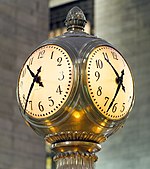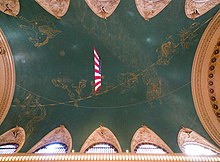Main Concourse
The terminal is one of the world's ten most-visited tourist attractions,[1] with 21.6 million visitors in 2018, excluding train and subway passengers.
[2] The Main Concourse is located on the upper platform level of Grand Central, in the geographical center of the station building.
[5] Opened with the rest of the terminal in 1913, the Main Concourse held numerous events, exhibitions, and other attractions over the next decades.
In the mid-20th century, the room started to deteriorate, its windows were darkened, advertisements were installed on its walls, and bank kiosks were placed on its floor.
The Main Concourse, on the terminal's upper platform level, is located in the geographical center of the station building.
The symbol was designed with the "T" resembling an upside-down anchor, intended as a reference to Cornelius Vanderbilt's commercial beginnings in shipping and ferry businesses.
[13] A door within the marble and brass pagoda conceals a spiral staircase down to a similar booth on the station's Dining Concourse.
An urban legend, which arose in news reports in the 1990s or even earlier, claimed that the clock faces were actually made of opal, a precious gem, and that renowned auction houses had estimated their worth at millions of dollars.
[27] One of the four original clock faces was damaged in 1968 by a police officer's bullet, while he chased members of the Youth International Party who staged a protest inside the terminal.
[13][30] The terminal's primary departure board is located on the south side of the concourse, installed directly atop the two sets of ticket windows.
The blackboard still hangs as a relic in its original place in the Biltmore Room, but in 1967, its function was supplanted by an electromechanical display in the main concourse over the ticket windows.
[34] It was built by watchmaker Omega SA to a design by Advanced Computer Systems of Dayton, Ohio, which also installed it.
[36] Between March and September 2019,[37] the LCD boards — whose software had become unavailable[38] — were removed from their housings and replaced by LED video wall screens.
[36][37][39][40] Designed by the MTA and New York's State Historic Preservation Office, the LED displays are brighter, easier to read, and ADA-compliant; they are also the first of the boards to offer real-time updates to train information.
[49] Two sets of ticket offices span the south side of the room, on the east and west of the entryway from Vanderbilt Hall.
[50] A false ceiling of square boards, installed in 1944, bears an elaborate mural of constellations painted with more than 2,500 stars and several bands in gold set against a turquoise backdrop.
The original mural, conceived in 1912 by architect Warren and painter Paul César Helleu and executed in 1913 by Brooklyn's Hewlett-Basing Studio,[54][55] became water-damaged and faded by the 1920s.
There is only one entrance from the south end – a wide bridge spanning over the Oyster Bar ramps leading into Vanderbilt Hall.
It uses the same stone as the west staircase, as well, as a similar design (modified for ADA compliance, and to show close observers that it is not original).
The concourse is lit by ten globe-shaped chandeliers in the Beaux-Arts style, each of which weighs 800 pounds (360 kg)[62] and contains 110 bulbs.
[60] The concourse's large American flag was installed there a few days after the September 11 attacks on the World Trade Center.
Due to Grand Central's importance in civilian and military transit, many of the terminal's windows were covered with blackout paint, which would prevent aerial bombers from easily detecting the building.
The mural, which had a montage of photographs, was part of a campaign to sell war bonds, and its unveiling was a nationally broadcast event that also drew 3,000 people on-site.
[67] A large flag also hung in the Main Concourse honoring the 21,314 New York Central Railroad employees that participated in the war.
Since the mid-20th century, the room started to deteriorate, as its windows were darkened, advertisements were installed on its walls, and bank kiosks were placed on its floor.
[69] During World War II, a large mural with images of the United States military hung in the concourse,[69] and from the 1950s to 1989, the Kodak Colorama exhibit was a prominent fixture.
[76][77][78] Politicians such as U.S. presidents Calvin Coolidge and Harry S. Truman; presidential candidates Thomas Dewey and Robert F. Kennedy; and governor Herbert Lehman have also held events within the concourse.
These include the nearby Biltmore Hotel (designed by Warren & Wetmore and built in 1913), which held a palm court modeled after the Main Concourse.
[86] The concourse's architecture, including its central clock, is depicted on the stage of Saturday Night Live, an NBC television show.
[90][91] The theater lobby featured an astronomical mural, which has similar colors and style to the Main Concourse ceiling.












